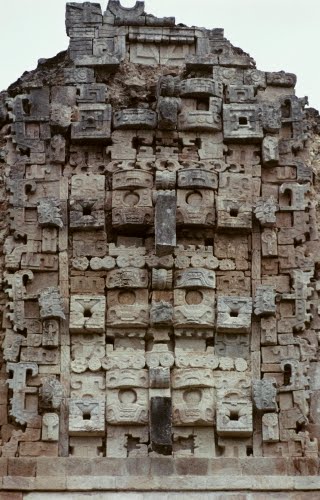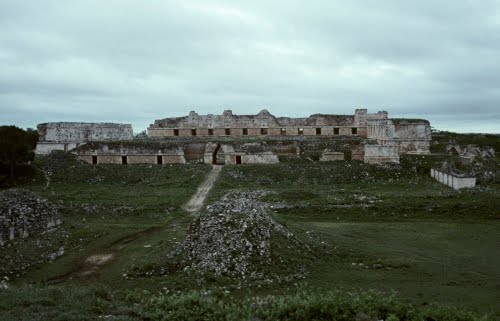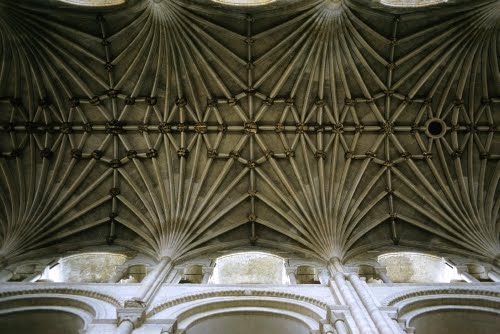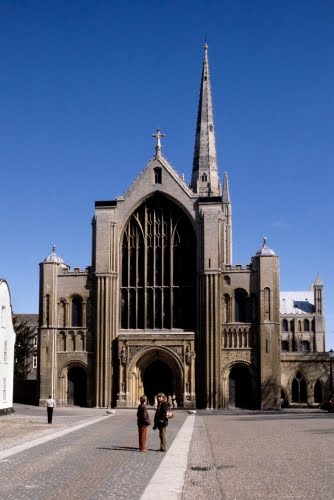It's All in the Details: Uxmal and Norwich Cathedral
Two weeks ago, my brother visited a friend in Rome and he raved about their visit to the recently re-opened—after almost 20 years—early Christian church of Santa Maria Antiqua. It has some of the oldest Christian paintings and a rich variety of Byzantine-style mosaics. It’s difficult to get a good idea of the overall view of that church because of all of the centuries of add-ons and renovations. It made me think that maybe details of venerable architecture, like the wall paintings in Santa Maria Antiqua, are as fascinating as looking at the overall architecture itself. Over the next few days I will show you some architectural details that I’ve always found noteworthy.
 |
| Maya Culture, Ancient Mexico, façade detail from North Building of the “Nunnery,” Uxmal, ca. 600–900 CE. Image © 2017 Davis Art Images. (8S-11400) |
This is an example of what art historians call “mosaic stonework.” It is a particularly fine feature of many of the Classic period (ca. 250–900 CE) Mayan buildings, particularly in the Puuc Hills. Typical of such stonework is the inclusion of the hook-nosed masks of the rain god Chac that run vertically down the center of this panel.
We are unfortunately stuck with the nickname “nunnery” from the Spanish conquerors who named everything they saw on Western religious architecture (the only religious architecture they knew). The North Building is probably the most important of the four facing a quadrangle and has 74 interior (corbeled) vaults. It is thought to have been an institution that trained military personnel, priests, or the warrior elite.
Uxmal was a Mayan-controlled city on the Yucatan in the Puuc Hills. It was firmly under a Mayan dynasty and constructed during the Late Classic period (ca. 600–900 CE). The most flourishing period for the city was between 800 and 1000 CE. The dynasty may have been related to the ruling families of other Puuc cities such as Kabáh, Sayil, and Labná, because there are similarities in architectural styles.
Puuc architectural style also appears in Chichén Itzá, so there may have been connections there as well. In Terminal Classic times (ca. 900–1200 CE), these cities had connections with the Putun Maya (in the Mexican lowlands) who set up expanded trade routes into the Caribbean and what today are Honduras, Belize, and Guatemala.
 |
| Maya Culture, Ancient Mexico, “Nunnery,” Uxmal, general view, ca. 600–900 CE. Image © 2017 Davis Art Images. (8S-11397) |
****************************************
When it comes to extravagant vaulting in Gothic buildings, British churches are right up there at the top of the list. Of course, the most famous are those in the cloister ambulatory fan vaults at Gloucester Cathedral (ca. 1350s). It is considered one of the most decorated nave vaults among late Gothic British cathedrals. Although most art history books give bracket dates to the Gothic period as ca. 1200–1400, the style continued in building through the 1400s in northern Europe.
 |
| Britain, Nave vault of Cathedral of the Holy Trinity, Norwich, mostly 1096–1145, nave rebuilt by 1278, then again in the 1460s. Image © 2017 Davis Art Images. (8S-24241) |
Although one sees the original Romanesque walls of the 12th century nave in Norwich Cathedral, the nave was renovated twice within two hundred years: first after a fire in 1171, and then after the spire was struck by lightning (1463) and the nave roof burned. The original wooden vaulting was replaced with these glorious fan vaults. The short ribs connecting the ribs of the fan vault are called lierne ribs, a French innovation to strengthen the support of the vault. Such vaulting is sometimes known as a lierne vault. The great thing about these added ribs is that it gave the artists who decorated the church an excuse for more decorative bosses at the intersections with the other ribs of the vault.
 |
| Britain, Cathedral of the Holy Trinity, Norwich, west façade, mostly 1096–1145, nave rebuilt by 1278, then again in the 1460s. Image © 2017 Davis Art Images. (8S-24235) |
Other posts in this series:
Indian and Iranian Architecture
Federal Style and Early Modernist Architecture
Correlations to Davis Programs: A Personal Journey: 8.4; A Community Connection: 3.4; The Visual Experience: 11.4, 13.2 14.2; Discovering Art History: 4.2, 4.7, 8.2

Comments